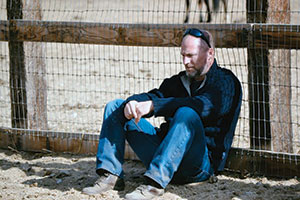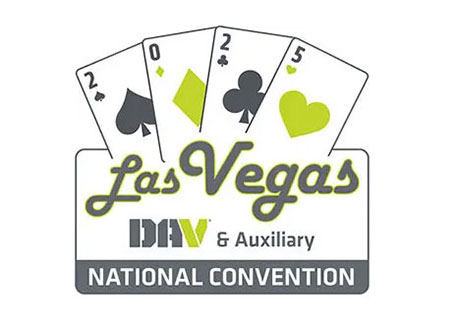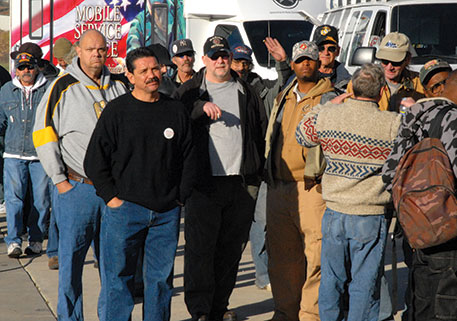
Being around guns was a normal part of Jake Clark’s life. He owned them. He used them during stints in the Army during the Cold War era and later in the California Army National Guard after 9/11. He carried a firearm daily as a Los Angeles police officer.
But deep beneath it all—the uniforms he wore, his professional proficiency with firearms and an outward appearance of success—were the scars of childhood sexual trauma, a secret past that Clark said led him to believe he was “defective, helpless and alone and that the world wasn’t safe.”
That false narrative fed a growing thought that he should take his own life.
Instead of acting on it, he gave the guns he owned away. That was in 1998, and from then on, the only firearms he was around were for his military duties—weapons he felt he didn’t have permission to use to harm himself.
Clark knew he needed help, and voluntarily removing his access to lethal means gave him the time and space to find it.
What he instinctually recognized 26 years ago is now backed by research as an effective way to reduce death by suicide. Lethal-means gun safety, or safe gun storage, is a suicide prevention measure that creates a self-imposed barrier between a person and their firearms. This barrier could be using a gun lock or safe, temporarily storing guns at a firearms dealer, or giving them to a friend or relative to hold on to.
Dr. Russell Lemle, a senior policy analyst with the Veterans Healthcare Policy Institute, said people with thoughts of suicide often have them on a spectrum over time.
“People will go in and out of suicidal thoughts and ideation over long stretches,” he said. “But the decision, ‘I’m going to end my life. I’m going to take my life,’ often comes up in a very impulsive way.”
Safe gun storage interrupts that impulse—which is usually within 10 minutes of the thought and is fleeting—and gives people an opportunity to hesitate, reconsider and calm down.
“And that is the lifesaving piece,” said Lemle.
Firearms are by far the most prevalent method used in veteran suicides, used 72% of the time—a rate that is much higher than nonveteran suicides. Notably, DAV’s most recent women veterans report, Women Veterans: The Journey to Mental Wellness, cites 2023 Department of Veterans Affairs findings that nearly 52% of all women veteran deaths are through the use of a firearm—more than all other methods combined and 17% higher than nonveteran women.
Lemle, who was a consultant for the report, said that the current cultural norm is open storage, meaning firearms can be very quickly accessed. Lethal-means safety could be the difference in ensuring someone makes it through the crisis in an impulsive moment.
He said a pervasive myth, despite contrary evidence, is that there is little to no connection between firearms and suicide—that someone intent on dying will find a way whether they have quick access to firearms or not.
But there is an association. Safe storage improves the chance of surviving. And gun culture is beginning to show signs of change.
The culture shift started 15 years ago when the firearms retailer community in New Hampshire began looking at ways to identify people who were at risk of harming themselves. This came after three customers of a single retailer in the state purchased weapons and took their own lives in the span of a week. Retailers formed the New Hampshire Gun Shop Project to share information and resources with the firearm-owning community.
That initiative grew into coalitions in 25 states, distributing material for gun retailers, gun dealer associations, shooting clubs and gun shows to share with customers.
Then, five years ago, the National Shooting Sports Foundation (NSSF), which is the firearm industry’s trade association, partnered with the VA and the American Foundation for Suicide Prevention to promote safe firearm storage messages, toolkits and programs.
The NSSF’s advocacy and support from policy experts, lawmakers, the VA, DAV and other organizations are pushing this message further to make it a prevailing narrative for those who own guns to help prevent suicide by firearm.
“The more we talk about the effectiveness of safe storage and provide people with the resources on how to be a part of the solution, the more veterans’ lives we will save,” said DAV Assistant National Legislative Director Jon Retzer, who has been an active participant in lethal-means safety policy roundtables with the VA and lawmakers.
Lemle said shifting cultural norms takes a long time, and we’re only at the beginning of the transformation.
Like the New Hampshire coalition, the epicenter for these culture-shifting conversations will be in firearms stores, said Dr. Gala True, a social scientist and researcher with the VA.
“If we want to address the issue of firearm suicide, especially in veteran communities, we really need to engage those partners,” she said. “They’ve got shared sense of community a lot of the time. There can be a lot of trust there.”
One of those partners is Caleb Morse, an Army veteran and owner of The Rustic Renegade, a firearms store in Lafayette, Louisiana. He started holding weapons for people in 2019 after an out-of-state friend from the Army showed up one day at his store with all his weapons and asked Morse to take them.
He took them but realized there was more he could’ve done in the moment. His friend is still alive, but Morse makes sure he has open, frank conversations about suicide prevention that he didn’t at the time. He won’t take someone’s firearm without sharing the resources available that will help them.
He uses his seven years of time in Iraq as a soldier and contractor as a way to connect with other veterans who come into his store to turn in their guns.
“It forces me to relive a lot of the pain that I’ve had, and it’s difficult. But it helps them, and then we help give them direction,” said Morse. “I’m just buying distance, and distance equals time. So if I can buy some time, I’m going to use that time.”
Morse currently has more than 100 firearms in safe storage and has stored more than 200 since he started taking them in.
“I can tell you out of all the individuals we’ve had store them, I’ve only had one we couldn’t help,” said Morse. “So I wholeheartedly know—I don’t just believe—I know it works.”
In 2021, True connected with Morse and, through the VA’s support, formed The Armory Project, a network of Louisiana firearms retailers that provide temporary, voluntary, out-of-home storage to anyone who needs it.
The network has grown to 15 retailers across the state, and through VA funding, True, Morse and others are working to expand the program further in Louisiana and into other states. The funding also helps them provide consultation services for others to start their own networks in their respective states.
“Success with this is not just someone storing their firearms with a retailer; it’s raising awareness about secure storage to save lives,” said True. “These retailers are really changing the culture and the conversation around secure firearm storage.”
Along with turning a weapon over to someone, safe storage includes any means that creates time and space between the impulse and the action. But for Clark, that decision to turn his firearms over 27 years ago started him on a path of healing.
In 2012, drawing from his experiences, research and 12-step journey, he founded Save A Warrior, an immersive intervention program that helps at-risk veterans address the challenges associated with post-traumatic stress disorder. Through the program, which continues to receive significant funding and support from DAV, he and his staff work with veterans to uncover their purpose and to connect with others.
More than 2,000 people have gone through his program, and it’s what continues to drive him. But that help can only start with a decision to put distance between the lethal means and the impulse.
“If I can create space, there’s hope,” Clark said. “This is a highly solvable problem. … The solution exists. I believe it in every fiber of my being.”




